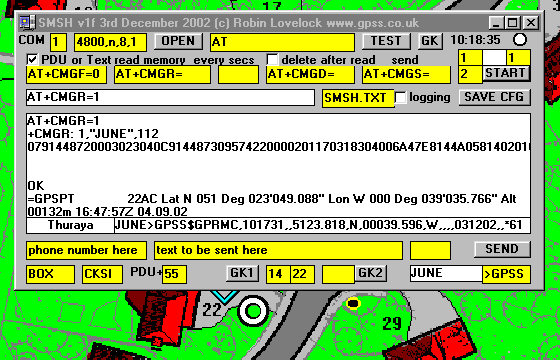
Home
GPS
Download
Business
Partners
Contact
Family
AVL
Links
History
AsOnTV
SMSH - SMS Handler for GPSS
Updated 1000 Tuesday 13th October 2009

Home
GPS
Download
Business
Partners
Contact
Family
AVL
Links
History
AsOnTV
SMSH - SMS Handler for GPSS
 Hi ! I've set up this page for those helping me test SMSH
- the SMS Handler for GPSS. Please look at the
SMS
page - if you have not already. This deals with the more basic questions
such as if you should be using SMS for your GPSS application,
or should you write your own software.
Hi ! I've set up this page for those helping me test SMSH
- the SMS Handler for GPSS. Please look at the
SMS
page - if you have not already. This deals with the more basic questions
such as if you should be using SMS for your GPSS application,
or should you write your own software.
I am very grateful to those who have helped me make such rapid progress with such a few hours of my time. In particular I would like to thank my old friend Klaus Hirschelmann, already mentioned on the RADIO page, who provided me the VB code to implement PDU conversion. Thankyou everyone who have provided me information or assisted in the testing.
SMSH runs on the same PC as GPSS and handles the GSM modem, or mobile 'phone being used as a modem, connected to the PC COM port. Incoming SMS Position Reports are translated into a standard format and injected into GPSS through the software interface.
SMSH is being used to test a wide variety of SMS products and systems - hence the large number of controls - but don't be frightened by this :-)
In the picture below, a Thuraya satellite phone has sent a GPS Position Report via SMS.

The picture shows SMSH in the foreground, being tested with GPSS in the background. SMSH would normally be run in the background, behind GPSS. The SMSH controls permit testing with various GSM modems and sources of SMS position reports.
Normally SMSH would be run, the START key clicked, then minimised. GPSS is then run and will automatically receive SMS Positions with SMSH hidden.
Before this is done the required parameters must be set up, such as COM Port (1 here) and baud rate (4800 here, or more typically 19200), and SAVE CFG clicked to ensure these values appear next time SMSH is run.
Other controls support testing of SMSH with different combinations of hardware being used as a modem on the PC, and sending Position reports.
The controls from the top are:
SMSH was only started on Friday 1st November 2002. We started with using "text mode" in the GSM AT+ commands. This meant not all mobile 'phones could be used as modems, since even those with modems may not support text mode - but need "PDU mode" (Protocol Data Units).
Version 1a of SMSH (Friday 1st Nov 2002) implemented Position Reports from:
Version 1i (Thu 9 Jan 2003) supports MV SEND polling, MTX02W. Iridium 9505 ISU (thanks to Boeing).
Version 1j (Fri 17 Oct) supports Garmin Navtalk (thanks to Lindsey).
Version 1k (Sat 27 Feb 2004) TXT2PDU for Test. Supports product for Armando.
Version 1L (2nd March) fix SEND bug for TXT mode. PDU mode SEND still not available.
Versions 1m to 1q (2007) in collaboration with Gregory on Partners page. iTrack units.
Version 1r (12 October 2009) support for Globalsat TR-101 trackers added.
Many engineers putting together SMS solutions for GPS based tracking have tended to "do their own thing" and invent their own message format. Some formats are suitable for phone-to-phone tracking without a PC, with the user simply looking at the message on his phone display. Others are used to pass the SMS into a PC application like GPSS for map display. Many of these formats are already in SMSH.
Here is a draft "open" format that some of you may wish to adopt. After feedback and implementation, we will support it in SMSH.
It attempts to be suitable for both types of use above. It should be simple to implement because the GPS will be passing very similar data into the SMS/GPS product, such as the $GPRMC NMEA message:
$GPRMC,141948,A,5041.12,N,00557.59,E,30,070,190500,,*2D
Here is a minimum implementation, with lat/lon only:
504112N0055759E
i.e. the $GPRMC lat/lon but without commas: the GPSS 15 character format.
Here is an implementation with direction and speed added:
504112N0055759E
070 at 30 nmph
i.e. followed by heading (degrees clockwise from true north) then speed in knots.
Some discussion may be need on whether would be better to have speed in km
or mph, and or introduce additional text such as the "at". e.g. 30 nmph.
Here is the message but with an internal gazeteer (or landmarks)
based on data such as GPSS GTX files, giving the 'phone user more information.
512559N0004054W
M3J3 n Bagshot
Or ...
512559N0004054W
230 at 33 kmph
M3 J3 n Bagshot
Or ...
512559N0004054W
230 at 33 kmph
43km sw London
540m ne M3 J3
i.e. 43 kilometres south west of London and 540 metres north east of M3 Junction 3.
- as in GPSS WAW logic.